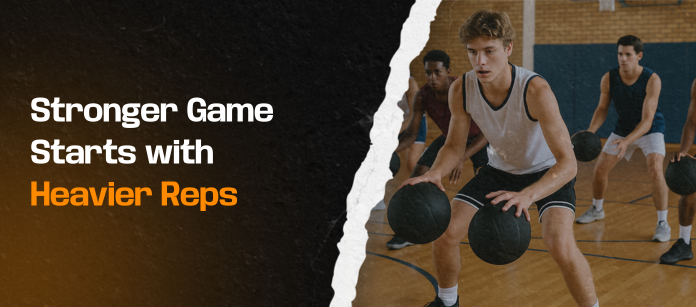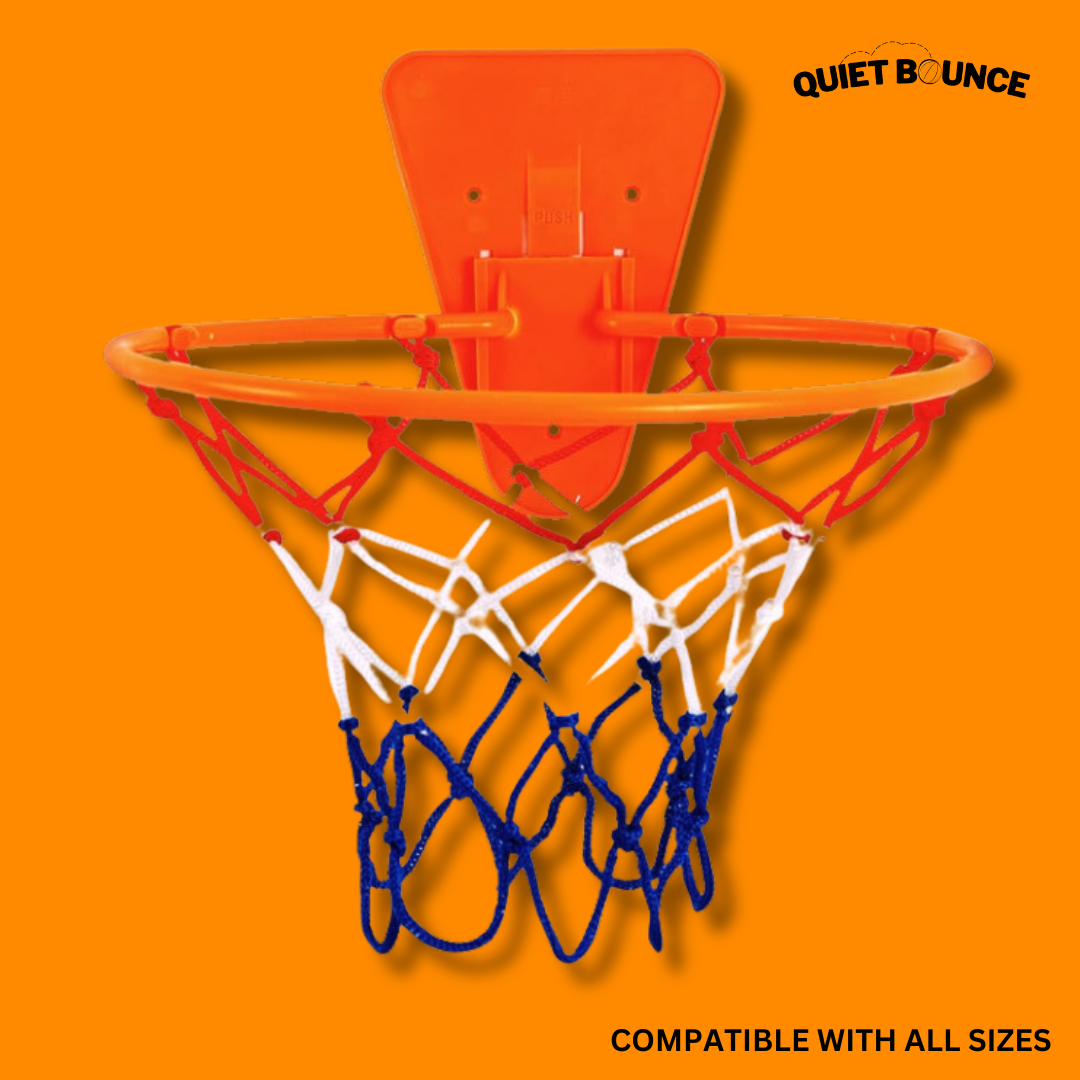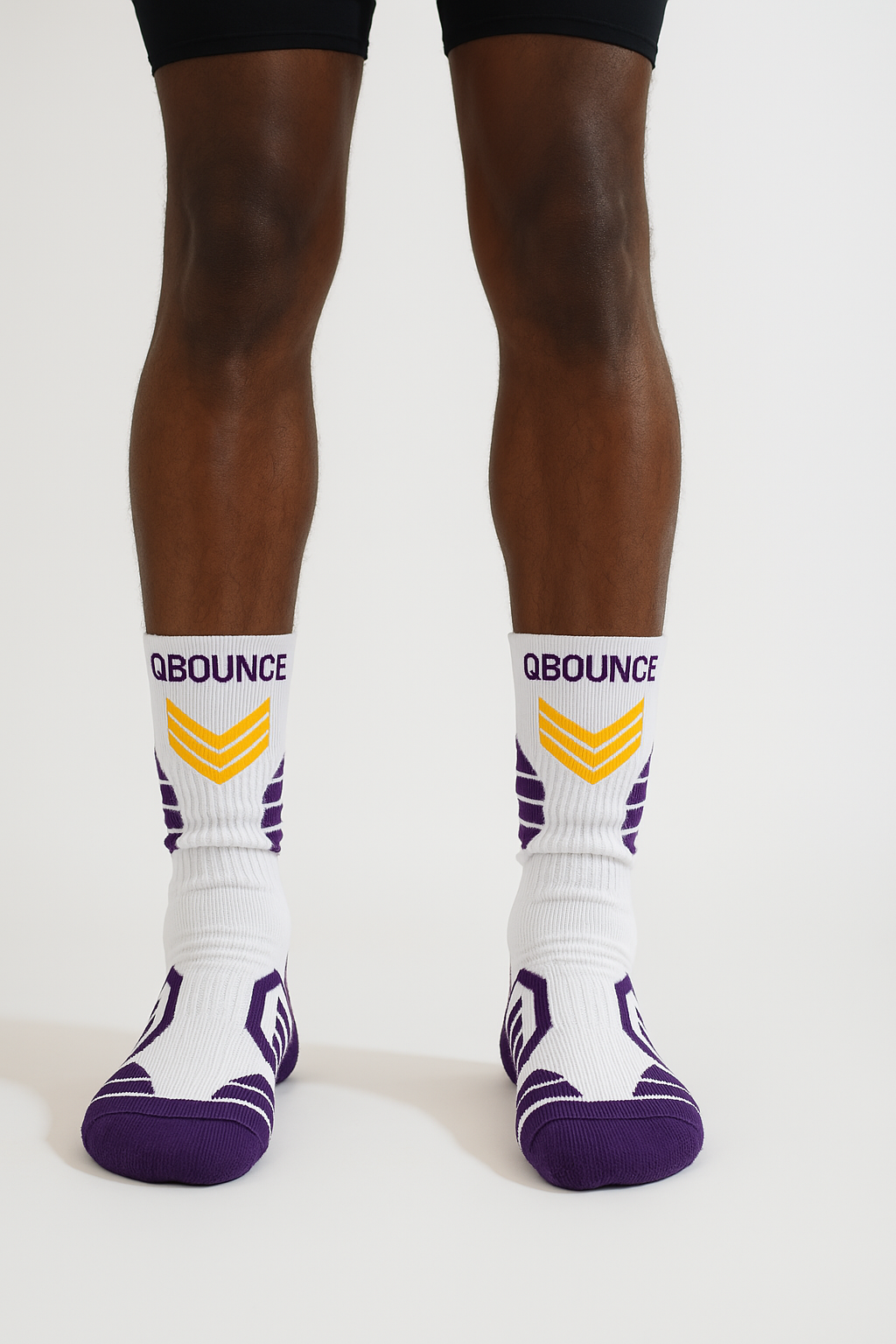
Benefits of Training with a Weighted Basketball
Share
If you want your regular basketball to feel faster, lighter, and easier to control, resistance training with a weighted ball can help get you there.
Key Takeaways
-
A weighted basketball builds upper body strength and improves muscle memory for better passing, shooting, dribbling, and rebounding.
-
Training with a heavy ball increases endurance, balance, and court control, helping players perform with more power and precision.
-
Drills with weighted basketballs can sharpen hand speed, reduce turnovers, and enhance shooting range under fatigue.
-
Pro players and coaches use resistance basketball training to develop strength and agility.
-
Weighted basketball drills include dribbling, passing, rebounding, and shooting workouts - ideal for home or gym sessions.
A weighted basketball looks almost identical to a standard one but once you pick it up, the difference is clear. Heavier by design, it adds resistance to every rep, forcing your body to work harder with each dribble, pass, or shot.
Used strategically, the benefits of a weighted basketball extend far beyond strength alone - they improve ball control, reinforce mechanics, and develop the muscles you rely on during real games.
Just starting out? Learn how to dribble a basketball the right way before layering in resistance.
Why Train with a Weighted Basketball?
Weighted basketballs aren’t for show, they’re designed to introduce controlled resistance into skill work. The added weight activates muscles that a regulation ball often ignores, especially in the wrists, forearms, and shoulders. Over time, that translates into tighter ball control, stronger passes, and smoother mechanics.
Coaches often use weighted basketballs to correct sloppy habits that sneak in when players rely on speed instead of control. And for athletes, it’s a way to make regular drills feel harder - so game-day reps feel lighter, quicker, and more automatic.
If your goal is to make a basketball team, mastering core skills like dribbling, passing, and shooting is only half the equation. Strength, control, and conditioning play a big role and that’s where resistance training with a weighted basketball starts to pay off.
Key Skill Improvements from Weighted Basketball Training
A weighted basketball demands more from every movement. Every dribble asks more of your wrists and forearms. Every pass travels slower, forcing you to generate power and focus on form. Over time, these micro-adjustments become long-term gains: sharper coordination, cleaner mechanics, and better performance when the game speeds up.

From solo basketball training at home to structured workouts on the court, a heavy ball builds stronger, more controlled movements. The goal isn’t to make things harder for the sake of it - it’s to make regular reps feel more efficient, and live play feel easier.
Now let’s break down what improves when you train with a weighted basketball - starting with control.
Resistance-Based Skill Development
Instead of changing the drill, a weighted basketball changes how your body responds to it by adding just enough resistance to activate underused muscles and demand better mechanics.
Over time, players build strength while improving grip stability and fine motor control. This type of resistance basketball training is about efficiency. You train the exact movements you’ll rely on during games, just with more load. That brings sharper execution when the pressure’s on, and more stamina in the final minutes.
Better Dribbling Control and Ball Handling
Practicing with a weighted basketball helps sharpen muscle memory and control - but it works even better when combined with the right technique. If you're just starting out, these basketball dribbling drills for beginners offer a solid foundation to build timing, rhythm, and touch. Once you layer in the added resistance of a heavy ball, you’ll feel your hands working harder and reacting quicker.
As your body adapts to the resistance, switching back to a standard ball feels easier: your hands are faster, your touch is lighter, and your reaction time improves. This kind of focused ball control training helps reduce turnovers and boosts confidence under pressure.
Coaches often recommend pairing a weighted ball with non-dominant hand dribbling drills to balance out strength and improve ambidexterity. It’s one of the most efficient ways to build a reliable handle that holds up during real games.
More Accurate and Powerful Passing
By practicing bounce passes, overheads, and no-look feeds with a heavy ball, players naturally develop better wrist snap and follow-through. That leads to more accurate passes in situations that demand speed, precision, and quick decision-making - like fast breaks or defensive traps.
Coaches often incorporate resistance basketball training to condition both mechanics and mental focus. Once you're back to a standard ball, the effort feels lower, the movement cleaner.
Increased Shooting Power and Range
Shooting a regulation ball from deep range requires more than just good form. It demands arm strength, core stability, and stamina. A weighted basketball builds all three. By adding resistance to your regular shooting motion, it conditions the same muscles used in your jumper.
Players who train with a heavy training ball often report better follow-through and less strain when they return to a standard ball. Over time, that can help extend your range and maintain accuracy, even when you're tired. It also improves shot mechanics under pressure, reinforcing proper form when your body starts to break down.
Just like strength training in the gym, these adaptations take time. But paired with spot shooting or form drills, a weighted basketball becomes a practical tool for increasing your in-game shooting potential.
Improved Rebounding Strength
Winning rebounds takes more than timing your jump. You need upper-body strength to hold your ground, fight through contact, and secure the ball on impact. A weighted basketball helps train that exact type of explosive strength.
While you won’t always simulate live rebounding scenarios in solo workouts, drills like high passes, toss-and-catch rebounds, or wall taps with a heavy ball can improve your grip, forearm endurance, and reaction time. Over time, this translates to better second-effort plays and stronger board presence in games.
And because rebounding requires repeated jumps and quick muscle activation, adding resistance to your training can improve vertical explosiveness indirectly, building the kind of whole-body coordination that makes rebounds easier to win.
How Long and How Often to Train with a Weighted Basketball
Like any resistance-based tool, a weighted basketball works best when it complements your training, not replaces it. Going too hard too fast can lead to fatigue or even injury - a real risk for younger players still building foundational strength and coordination.
Beginner Recommendation:
Start with 5-10 minutes of light ball-handling or passing exercises 2-3 times per week. Focus on short sets that build hand control and forearm endurance without overloading your joints.
Intermediate to Advanced Players:
Once comfortable, ramp up to 15-20 minutes per session, 3-5 times a week. You can also introduce more demanding routines, such as partner passing or shooting reps while fatigued. Just make sure to pair your heavy-ball work with regular drills using a standard ball to avoid over-adjusting your shot or pass mechanics.
Avoid Overuse Injuries
The added weight may not feel extreme, but your wrist, elbow, and shoulder tendons will feel the difference. Build in recovery time. Pay attention to soreness. And don’t rely on a heavy ball every session. The goal is to enhance performance, not compromise mechanics.

Do NBA Players Use Weighted Basketballs?
Weighted basketballs have made their way into elite skill work, not just for youth training or home workouts. While they aren’t part of full-team scrimmages or regulated practices, you’ll find them in the hands of pros during off-season development and pre-game routines.
Skills coaches like Drew Hanlen and Chris Brickley, known for working with top-tier pros, have publicly incorporated heavy training ball drills into their shooting warmups, passing sequences, and ball handling circuits. These drills help players sharpen their motor control, reinforce muscle engagement, and maintain intensity.
In fact, some players even use a weighted basketball during low-dribble sequences to enhance hand speed and force precision. Professional-level adoption doesn’t mean every player needs to train this way, but it underlines the idea: if used correctly, a weighted ball can become a low-risk, high-reward tool for building performance at any level.
Best Drills with a Weighted Basketball
A weighted basketball doesn’t need its own workout plan - just swap it in for your usual reps. That subtle shift adds resistance to drills you already know, building strength and sharpening mechanics while keeping the structure of your routine intact.
Stationary Ball Control Drills
Keep it simple: pound dribbles at different heights, crossovers, and non-dominant hand dribbling drills. The added weight makes every motion more deliberate. You’ll feel it in your wrists and shoulders after just a few minutes - and your handle will tighten up fast.
Two-Ball Dribble Combos
Train symmetry and coordination by pairing your weighted basketball with a regular one. One hand focuses on control and strength, the other on rhythm and reaction. Switch hands every set. This combo helps players develop advanced coordination - a key advantage when pushing past basic types of dribbling in basketball.
Wall Passing
Stand 6-8 feet from a wall and fire passes using your heavy training ball. Focus on quick release, tight spin, and wrist extension. The goal: reduce arm fatigue and build a fast-twitch reaction when switching back to a standard ball.
Spot Shooting
Shoot from 10 to 15 feet using a weighted basketball. The goal here isn’t to perfect your stroke, it’s to challenge your mechanics under resistance. That added load forces your body to stabilize through the motion. When you switch back to a standard ball, most players notice smoother extension, better follow-through, and a surprising boost in range.
Partner Passing
Pair up and pass continuously: chest passes, bounce passes, one-hand whip passes. Go for speed, clean mechanics, and endurance. Many players overlook this one, but it’s foundational for game-time passing under pressure.
Rebounding & Box-Out Work
Toss the heavy ball against the backboard and focus on securing position, grabbing the rebound cleanly, and going up strong. The added weight demands full-body effort, driving power from your legs, stabilizing through your core, and finishing with controlled upper-body strength.
Buying Guide for Weighted Basketballs
Training with a weighted basketball is only as effective as the ball itself. The wrong model can feel slippery, overly dense, or just too awkward to use consistently. Here’s what to consider before picking one up.
Weight & Resistance Level
Weighted basketballs typically range from 1.5 to 3 lbs, but even subtle differences can affect the way your muscles respond. For youth players or beginners, starting at the lighter end prevents strain and keeps drills fluid. Advanced players looking to intensify resistance basketball training can step up the weight incrementally - but always prioritize control over heaviness.
Grip & Texture
The best heavy training ball replicates the texture of a regulation ball. Deep channels, consistent grip, and quality rubber or synthetic leather are beneficial during fast-paced drills, where grip fatigue quickly sets in.A slick surface undermines the whole point of muscle memory work.
Size & Regulation Feel
Most weighted basketballs are offered in men’s (29.5”) and women’s (28.5”) sizes to keep the transition between training and gameplay smooth. For youth players, using a ball that matches their competitive size builds coordination and confidence faster.
Indoor vs. Outdoor Use
If you’re mostly doing basketball training at home, particularly on indoor floors, look for a model with softer materials that won’t scuff floors. Outdoor use calls for extra durability: abrasion-resistant materials and reinforced seams make all the difference.
Durability & Build Quality
You want a ball that holds up under high-rep workouts. Foam core models tend to compress quickly, while composite leather or rubber-core options offer more longevity. If you’re serious about integrating it into daily drills, prioritize a ball known for bounce retention and structural integrity. Choosing the right model ensures you get the full weighted basketball benefits - durability, feel, and consistency that lead to real progress.
Recommended Brands and Models
|
Product |
Weight Options |
Size |
Grip & Feel |
Best For |
Indoor/Outdoor |
Price |
|
3 lbs |
29.5” |
Game-like texture, deep channels |
All-around resistance training |
Both |
$56.97 |
|
|
2.2 lbs (Size 6), 3 lbs (Size 7) |
28.5”, 29.5” |
Faux leather, solid control |
Passing, rebounding |
Indoor/outdoor |
$27.99 - $28.99 |
|
|
3 lbs |
29.5” |
Durable rubber, high bounce |
Dribbling drills, strength |
Both |
~$66.99 |
|
|
2.2–3.3 lbs |
29.5” |
Textured PU, anti-slip |
Grip work, high-rep drills |
Outdoor-heavy use |
~$19.99-$27.19 |
Ready to Level Up?
If your skills have plateaued, a weighted basketball is one of the simplest ways to break through. It doesn’t require fancy drills or extra gym time, it just amplifies the work you’re already doing. Every rep becomes harder. Every movement gets cleaner. Over time, you don’t just see results - you feel them: stronger passes, sharper handles, deeper shots, and faster reactions.
Coaches rely on resistance basketball training because it develops mechanics that hold up. It’s a style of training that strengthens coordination, balance, and reaction time. Not by changing the game, but by changing how your body handles it. The extra weight doesn’t pretend to build skill. It makes sure you earn it.
Train heavier now so the game feels lighter later. Start with the QBounce weighted basketball and feel the difference in every rep.
Frequently Asked Questions (FAQ)
1. What are the benefits of training with a weighted basketball?
A weighted basketball builds muscle memory, forearm and wrist strength, and hand speed - all while reinforcing proper mechanics. Over time, your regular basketball feels lighter, and your movements become more controlled and explosive.
2. How does a weighted basketball improve dribbling skills?
It forces your hands, wrists, and forearms to work harder with every bounce. That effort sharpens fine motor control and increases hand speed. When you switch back to a regulation ball, you’ll notice tighter handles and quicker reactions.
3. Is shooting better after using a weighted basketball?
Yes, many players report improved shot power, cleaner follow-through, and deeper range. The extra weight engages more upper-body and core muscles during reps, building the strength needed to maintain form under fatigue.
4. How long should I train with a weighted basketball?
Beginners should start with 5-10 minutes of light drills 2-3 times per week. Advanced players can push to 15-20 minutes, 3-5 times weekly. The key is moderation: use it to complement, not replace, regular ball work.
5. Do NBA players use weighted basketballs for practice?
Yes, many pros and their trainers incorporate them into pre-game routines and off-season skill work. Coaches like Drew Hanlen and Chris Brickley have publicly used them to refine shooting, passing, and ball-handling mechanics.
6. Can weighted basketballs improve my in-game performance?
Absolutely. The resistance training translates to stronger passes, quicker hands, and more efficient movement under pressure. The gains are especially noticeable in rebounding, shooting range, and fatigue management.
7. What drills work best with a weighted basketball?
Focus on dribbling drills, wall passes, spot shooting, rebounding taps, and partner passing. You don’t need a new routine, just replace your regular ball during common drills to add load and build strength.
8. Where can I buy a weighted basketball for training?
You’ll find reliable options on Amazon, sporting goods stores, and specialty sites. We recommend starting with the QBounce Weighted Basketball for its durability, grip, and game-like feel.
9. What's a good weighted basketball to improve my passing?
Look for models around 2.5-3 lbs with excellent grip and balance. The NEOGOAT or QBounce weighted balls are both strong options for working on bounce passes, chest passes, and fast-break feeds.
10. What is the best weighted basketball for outdoor use?
The Dakapal PU Weighted Basketball offers great traction and abrasion resistance for outdoor courts. Its anti-slip PU material holds up well under rougher surfaces and weather conditions.
11. Where can I find weighted basketballs that are heavier than normal?
Most standard weighted balls range from 2 to 3 lbs, but some models (like the Dakapal 3.3 lb or custom training balls) offer heavier resistance. Just be careful not to overtrain or compromise form.
12. What are the best weighted basketballs for developing ball handling skills?
Choose a ball that mirrors the size and texture of your game ball but adds 2-3 lbs of resistance. SKLZ and QBounce offer models that keep control tight during advanced ball-handling workouts.
13. I need a weighted basketball to increase my arm strength - what are my options?
Stick to heavier options in the 3 lb range. The QBounce and NEOGOAT Size 7 (3 lbs) models are excellent for building wrist, shoulder, and upper-body strength through passing and shooting reps.
14. What are some recommended weighted basketballs for improving rebounding?
Use balls with firm grip and even bounce. QBounce and Dakapal are ideal for high-toss rebound drills, box-out footwork, and reaction work off the backboard. The added weight builds explosive movement and grip strength.




